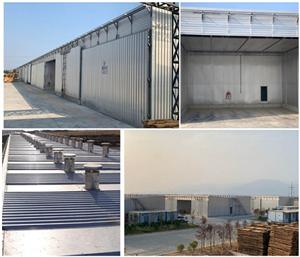Wood drying is a relatively complex process:3.Common defects and solutions in wood drying
Wood drying is a relatively complex process. There are many specifications, varieties and uses of wood. Each enterprise needs to work out a drying process that suits its own products according to its own production characteristics. Thereby ensuring the dry quality of the wood.
3. Common defects and solutions in wood drying
1. Cracking: The cracking phenomenon of wood in the kiln drying process has the following three situations:
(1) External cracks (surface cracks): refers to the longitudinal cracks along the wood rays on the outer surface of the sawn timber (usually the outer cut surface of the chord cutting board), which is mainly caused by excessive surface tension in the early stage of drying. Therefore, in the early stage of drying, try to avoid heating too fast and control the heating time gradient.
(2) Internal cracks (honeycomb cracks): The internal cracks of the wood occur inside the wood, cracking along the wood rays, such as honeycombs, also called honeycomb cracks. Internal cracks generally occur in the later stage of drying. The way to prevent it is to perform intermediate treatment in the middle and later stages of kiln drying to relieve surface hardening. For sawn timber with larger thickness, especially hard broad-leaved trees, the later drying temperature must not be too high.
(3) End cracking (splitting or longitudinal cracking): When the wood is dried in the kiln, the water at the end of the wood evaporates quickly, especially when the thickness of the wood is large, end cracking is easy to occur.
Prevention method: When stacking, the spacer at the end of the stack should be pressed as close to the end as possible and aligned up and down; when loading the kiln, the end of the stack and stack should be as close as possible to prevent airflow from the gap between stacks. Short-circuit to prevent the ends from drying too quickly; apply paraffin oil or thick paint to the ends of the boards to prevent water from evaporating from the ends; for hard hardwoods or thick boards that are prone to end cracks, try to use a softer drying process , and pay attention to timely humidification treatment.
- Aluminum Wood Drying Kiln
- New Type Steaming Heated Kiln for Wood Dryer
- Hot Water Drying Chamber For Wood Drying Machine
- Heat Transfer Oil Drying Kiln Drying Equipment
- Natural Gas Drying Kiln For Wood Dryer Machine
- Radiata Pine Drying Kiln Drying Chamber For Wood
- Rubber Wood Drying Kiln Timber Drying Chamber
- Rosewood Drying Kiln Channel Kiln For Wood
- Bamboo Drying Kiln Drying Machine
- Intelligent Wood Drying Kiln With Easy Operation
- Heat Pump Drying Kiln
- Heat Pump Wood Drying Kiln Dryer Without Boiler
- Heat Pump Drying Kiln for food
- Veneer Drying Equipment
- Track Veneer Drying Kiln
- Veneer Roller Dryer machine
- 3-layer Net-Belt Veneer Dryer for wood
- Wood carbonization kiln
- High Frequency Vacuum Wood Carbonizating Kiln
- Special kiln for carbonization of bamboo chips




